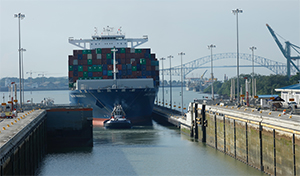As a high school student in Panama in the 1970s, Max Newman knew he wanted to be a tugboat master on the Panama Canal. Repeatedly denied acceptance to the canal’s tugboat mate apprenticeship program, he enrolled in a four-year program at the International Maritime University of Panama (formerly Panama Nautical School), with an additional yearlong internship at sea.
Yet even as an officer on a merchant ship, he clung to his dream. Newman has always been persistent. He raises his voice even now when he says, “How could they not understand that I wanted to be a tug master on the Panama Canal?” Eleven resolute years after leaving high school and earning a bachelor’s degree, he was hired into the training program. Today, nearly 30 years later, he’s exactly where he wants to be: manager of the tugboat section in the Transit Resources Division of the Panama Canal Authority (PCA).
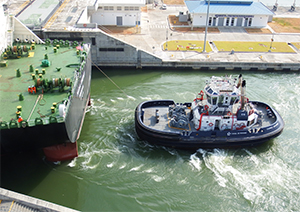 |
|
The tractor tug Cerro Grande keeps Marie Energy centered as the LNG carrier enters Cocoli Locks in March. |
|
Will Van Dorp |
Timing offered opportunities for Newman. He became a tugboat master on the original 1914 canal where tugs are used, depending on a transiting ship’s dimensions and characteristics, in conjunction with locomotives to maintain the vessel’s longitudinal position entering the locks and through the Culebra Cut. Then early in the 2000s, he was chosen to be part of a multidisciplinary PCA team tasked with helping to develop a proposal for accommodating ships too large for the two original sets of locks. The team studied the most up-to-date canals handling the largest cargo vessels, the canals leading to the European ports of Antwerp, Dunkirk and Terneuzen. The Berendrecht Lock, leading to Antwerp, was the world’s largest when it opened in 1989, with dimensions of 1,600 feet by 223 feet. Like the other two facilities studied, the Antwerp canal uses rolling gates instead of mitered ones, and tugboats instead of locomotives for positioning ships within a lock chamber.
The PCA team looked to adopt what Newman calls the “best practices for lock design, equipment and operator training.” Nowhere did they see locomotives. The PCA continued to use locomotives in the 1914 locks as ships became ever larger, but more locomotives per ship were required. Eight locomotives currently center the largest Panamax ships in the original locks, challenging the practicality of assisting in a safe and efficient manner.
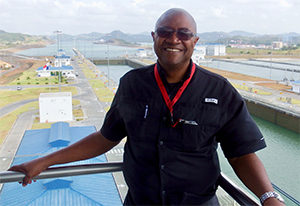 |
|
Years of perseverance led Capt. Max Newman to his long-sought dream job as manager of the Panama Canal Authority’s tugboat section. In the background are the Cocoli, Miraflores and Pedro Miguel locks. |
|
Will Van Dorp |
Inspired by this, the PCA decided the new third set of locks — the locks at Cocoli and Agua Clara — would dispense with locomotives and use tugboats instead. This was an assumption integral to planning from the outset. PCA representatives attended numerous national and international meetings, workshops and conferences, honing their plans. PCA experts also went to the Port Revel miniature-scale ship-handling school in Grenoble, France, operating on its 13-acre lake. The PCA then built its own 35-acre lake on which to train personnel in such tasks as positioning a ship safely inside a lock chamber, and guiding two neo-Panamax ships meeting “Texas chicken” style in the narrow Culebra Cut.
The PCA’s existing Center for Simulation, Research and Maritime Development (SIDMAR) was upgraded to replicate the challenges of transiting neo-Panamax vessels through the new locks, and it now rivals the Port Revel facility. Training using tugs instead of locomotives to guide transiting ships was also conducted in the 1914 locks. A month before opening day in June 2016, the PCA leased a neo-Panamax bulk carrier, MN Baroque, to conduct daily trial transits through the Agua Clara Locks to allow pilots, tugboat captains and deck officers to receive appropriate hands-on training.
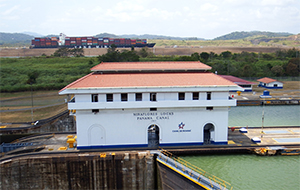 |
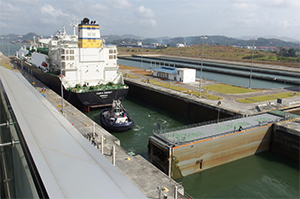 |
|
|
Locomotives use tracks, seen in front and behind the Miraflores Locks building, to guide ships in the original 1914 sections of the canal. In the new third set of locks, the task is left solely to tugboats. |
There are 16 rolling gates in the Panama Canal’s new set of locks, eight on each section. They weigh up to 4,200 tons each depending on the height of the gate. |
|
|
Will Van Dorp |
Will Van Dorp |
Not surprisingly, some tug masters perceive replacing locomotives with tractor tugs — which accompany the ships in the new lock chambers — as a major change. The tug masters expressed their concerns about safety as early as a year before the new locks opened and they have continued to do so, notwithstanding the PCA’s modification of procedures and emphasis on training.
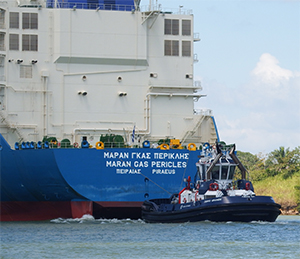 |
|
Cerro Grande assists the LNG carrier Maran Gas Pericles as the vessel plies the canal east of Gamboa, Panama. It takes a ship an average of eight to 10 hours to transit the waterway. |
|
Will Van Dorp |
In March, after almost 21 months of operation, the new locks had recorded more than 3,000 neo-Panamax transits, reaffirming the abilities and professionalism of the entire PCA work force involved in the process. Effective Dec. 1, 2017, the PCA was booking seven neo-Panamax slots per day, up from six, and it set the goal to increase that number to eight in the first half of 2018. That’s an increase from 5.5 ships during the first year of operation, which concluded in June 2017. Given the $5.25 billion cost of expansion, pressure exists to increase the daily number of neo-Panamax transits to 12, but the PCA refuses to move too quickly at the expense of safety.
In the interest of promoting safety as well as addressing the ongoing concerns of various captains’ unions, the PCA commissioned a health, safety and environmental study by The Marine Group. Last September, the PCA administration accepted the findings of the study, which some tug masters said wasn’t sufficiently thorough. The canal authority said it is analyzing the findings to make operational decisions related to incremental increases in neo-Panamax traffic.
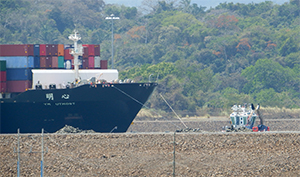 |
|
Only the pilothouse of Cerro Canajagua, the forward assist tug, can be seen as it positions the containership YM Utmost during an eastbound transit at Cocoli Locks. |
|
Will Van Dorp |
PCA statistics capture the scope of growth after expansion: 2017 saw the transit of 403.8 million tons of cargo, a 22.2 percent increase over 2016. Evidence of the growth also can be observed in the new buildings along the canal, the larger vessels transiting and procedural changes that include assigning two tugs to each neo-Panamax vessel — containership, passenger ship and LNG carrier— for the entire transit. These neo-Panamax ships use the new locks to climb to Gatun Lake level and then descend to ocean level, but for the midsection of the transit they follow the 1914 channels across Gatun Lake. This has necessitated the deepening and widening of these channels, another sign of growth, with dredging equipment in Gatun Lake and at the Pacific and Atlantic approaches working around the clock. Ten more tractor tugs also will enter the PCA fleet in 2018.
Of course, growth always comes with pains. Mistakes provide teachable moments. For Capt. Max Newman, what was true for him moving forward from high school is also true of realizing greater capacity in the new locks. As he says, “Fix yourself a goal and stay with it.”

